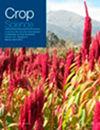Prediction‐based breeding: Modern tools to optimize and reshape programs
IF 1.9
3区 农林科学
Q2 AGRONOMY
引用次数: 0
Abstract
Prediction‐based breeding reshapes plant genetic improvement by prioritizing the predictive ability of models over causal interpretation. This review examines recent advances in the use of tools such as genomic selection, high‐throughput phenotyping, multi‐omics integration, and enviromics to enhance genetic gain and improve the efficiency of breeding programs. Predictive models, while powerful, rely on validation within the genetic and environmental domains represented in the training set, with evident risks when extrapolated to unrelated scenarios. Traditional approaches such as marker‐assisted selection and genome‐wide association study remain limited for quantitative traits, reinforcing the need for prediction‐oriented models. Moreover, the expansion of omics data sources, although capturing greater biological complexity, must be accompanied by rigorous validation practices to avoid fragile interpretations. Stochastic simulations are a strategic tool for testing selection schemes, optimizing training populations, anticipating overfitting risks, reducing costs, and guiding decisions based on prospective scenarios. This review also highlights the importance of ensuring independence between calibration and prediction, focusing on practical accuracy evaluation, and prioritizing operational utility over mechanistic explanation. In summary, prediction‐based breeding is a core strategy for modernizing breeding programs, connecting computational tools, high‐dimensional data, and pragmatic decision‐making to deliver consistent results.基于预测的育种:优化和重塑程序的现代工具
基于预测的育种通过优先考虑模型的预测能力而不是因果解释来重塑植物遗传改良。本文综述了基因组选择、高通量表型、多组学整合和环境学等工具在提高遗传增益和育种效率方面的最新进展。预测模型虽然强大,但依赖于在训练集中表示的遗传和环境领域内的验证,当外推到不相关的场景时,存在明显的风险。传统的方法,如标记辅助选择和全基因组关联研究在数量性状方面仍然有限,这加强了对预测导向模型的需求。此外,组学数据源的扩展,尽管捕获了更大的生物复杂性,但必须伴随着严格的验证实践,以避免脆弱的解释。随机模拟是测试选择方案、优化训练人群、预测过拟合风险、降低成本和基于预期情景指导决策的战略工具。这篇综述还强调了确保校准和预测之间独立性的重要性,关注实际精度评估,优先考虑操作效用而不是机制解释。总之,基于预测的育种是现代化育种计划的核心战略,将计算工具、高维数据和务实决策联系起来,以提供一致的结果。
本文章由计算机程序翻译,如有差异,请以英文原文为准。
求助全文
约1分钟内获得全文
求助全文
来源期刊

Crop Science
农林科学-农艺学
CiteScore
4.50
自引率
8.70%
发文量
197
审稿时长
3 months
期刊介绍:
Articles in Crop Science are of interest to researchers, policy makers, educators, and practitioners. The scope of articles in Crop Science includes crop breeding and genetics; crop physiology and metabolism; crop ecology, production, and management; seed physiology, production, and technology; turfgrass science; forage and grazing land ecology and management; genomics, molecular genetics, and biotechnology; germplasm collections and their use; and biomedical, health beneficial, and nutritionally enhanced plants. Crop Science publishes thematic collections of articles across its scope and includes topical Review and Interpretation, and Perspectives articles.
 求助内容:
求助内容: 应助结果提醒方式:
应助结果提醒方式:


